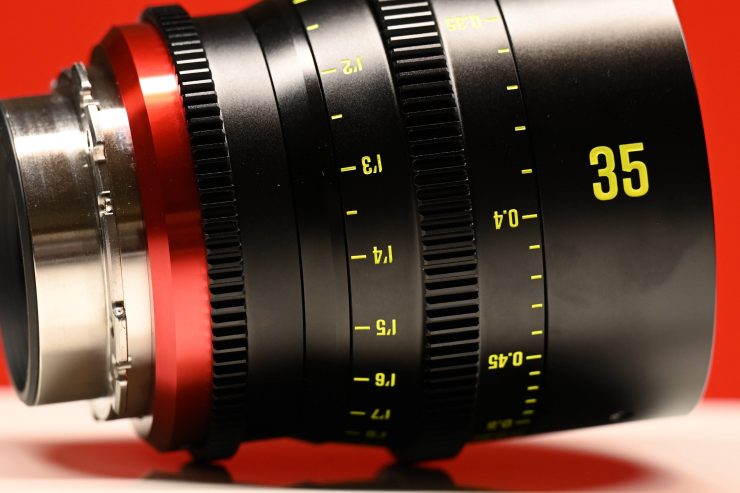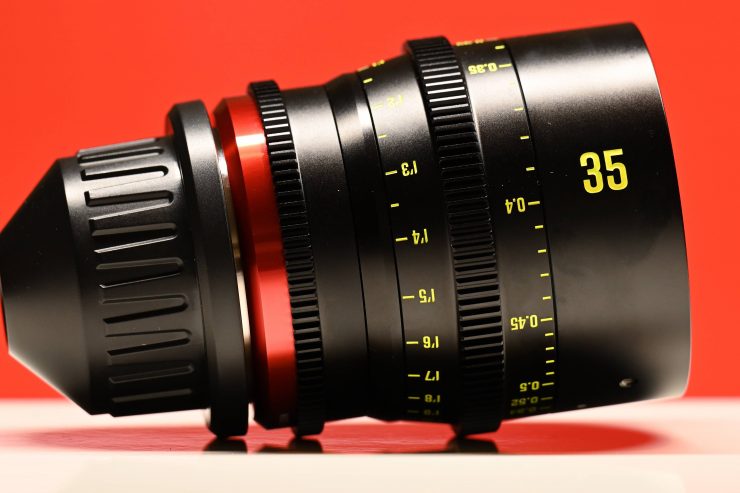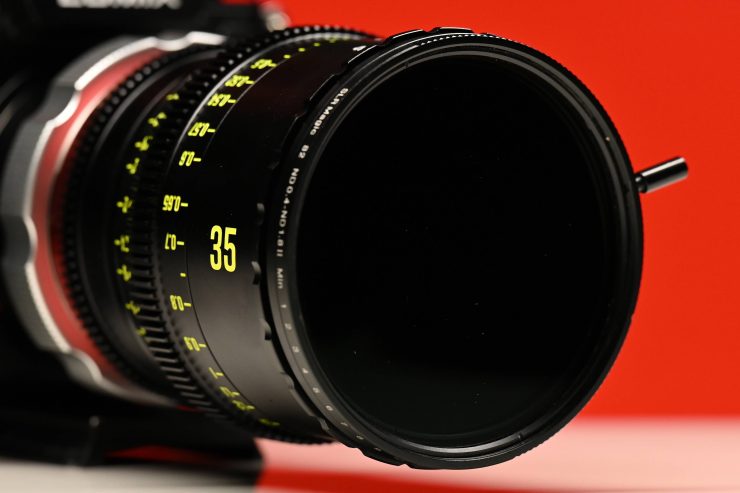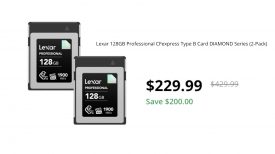
The Meike 35mm T2.1 Full Frame Cine Lens covers full-frame and larger sized sensors. It is available in either PL, Canon EF, Canon R, Sony E, and Panasonic L mounts. This is Meike’s second full-frame cine lens and it now joins the 50mm T2.1.
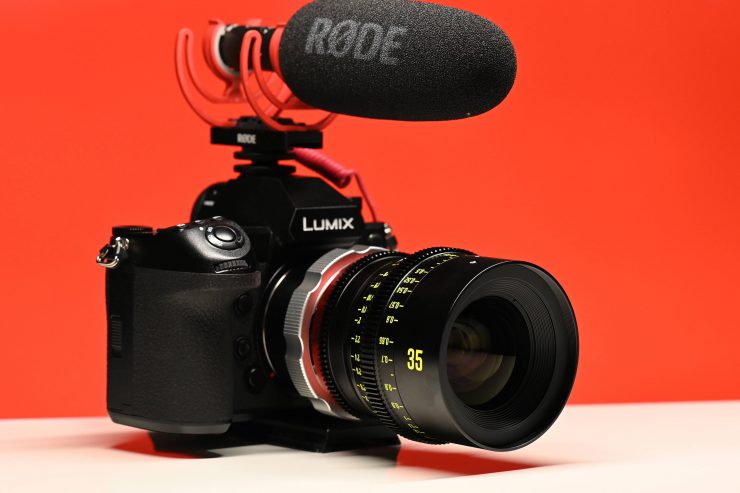
Who is Meike?
The story behind Meike is a little long and complicated and if you need more information check out this article by Matt Duclos.
The optical and mechanical design of the Meike primes appears to bear a striking resemblance to that of the original Veydra lenses, but there are a few key differences. The Meike lenses are claimed to be optically and mechanically better.
Concept
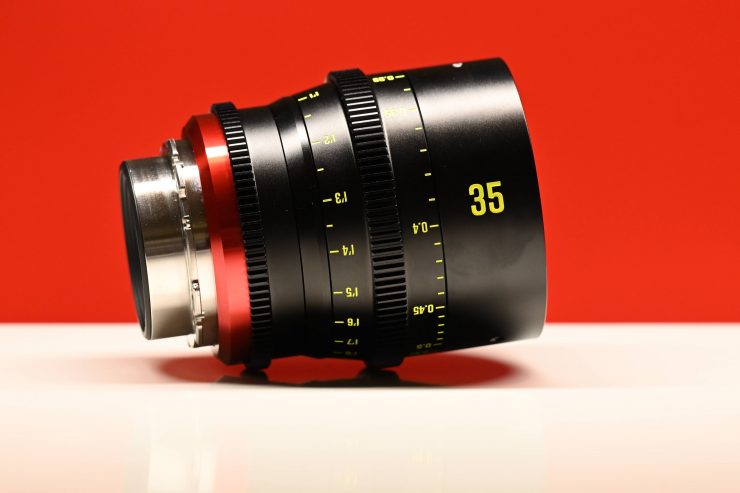
The lens is being touted as an affordable, compact-sized, full-frame cine prime lens. It looks to be a good option if you are thinking about getting a dedicated cine prime lens, but don’t have a lot of money to spend. In a lot of ways, lenses like these offer cine-style mechanics at the price point of a normal stills lens. A lot of these relatively new lens manufacturers such as Meike and DZOFilm have made quality cine lenses available to the masses.
As I have already mentioned it will cover full frame sized sensors. The actual image circle coverage is 45mm.
Is this lens actually new?
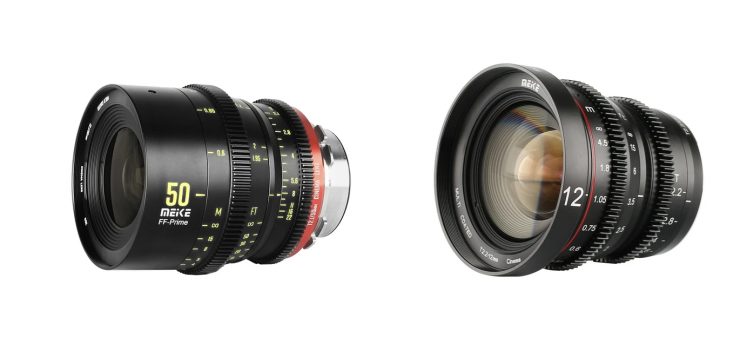
Meike already makes cinema prime lenses for M4/3, APS-C, and full-frame sized sensors. Lenses are available in Sony E-Mount, Fujifilm X-Mount, and M4/3 mount. The 35mm T2.1 Full-Frame lens is available in PL/EF/RF/E/L/Z mounts.
This new series is slightly different from the existing APS-C coverage lenses they already make. In saying that, there is still a lot of similarities between this new lens and some of the existing models.
Size & Weight
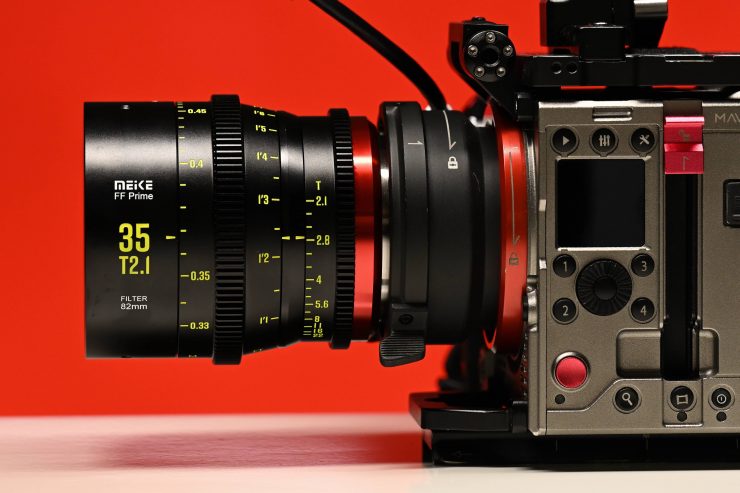
The 35mm T2.1 tips the scales at approx. 1108g / 2.44 lbs in PL and Canon EF mount. This is still quite a lot of weight for a small lens.
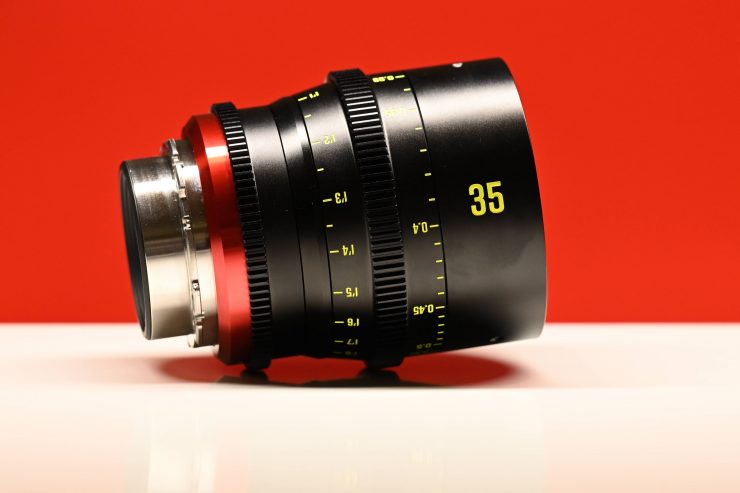
The PL-mount version is 98.5mm (3.88″) long and the Canon EF mount version is 106.5mm (4.19″) long.
Build Quality
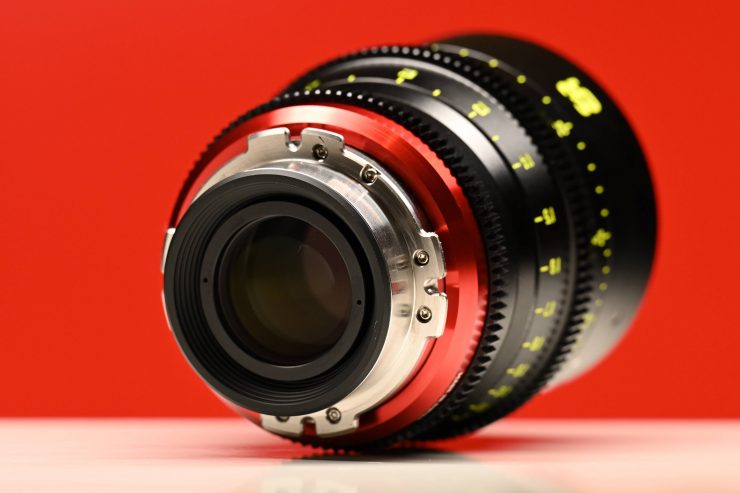
The lens feels solidly made (especially for a lens at this price). The focus and iris rings are nicely weighted, however, the focus ring has noticeably more friction when moving towards infinity than when it is moved back towards its minimum focus distance. This may be a very small and minor issue, but it is worth noting.
Markings
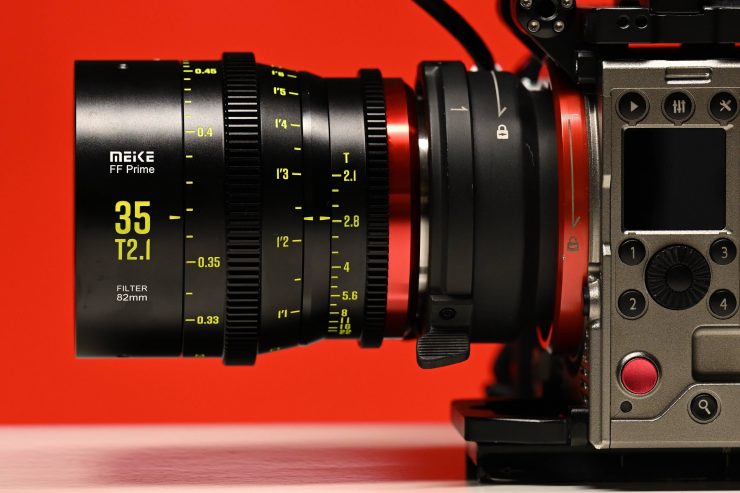
The markings on the lens are shown in both feet and meters, which is a little unusual. I suppose this saves on making multiple versions and it helps to keep the cost down. As this lens is very much being targeted at solo shooters and owner/operators you will notice that the markings will appear upside down on the non-operators side of the lens. I don’t personally see this as any kind of problem, but it is with mentioning.
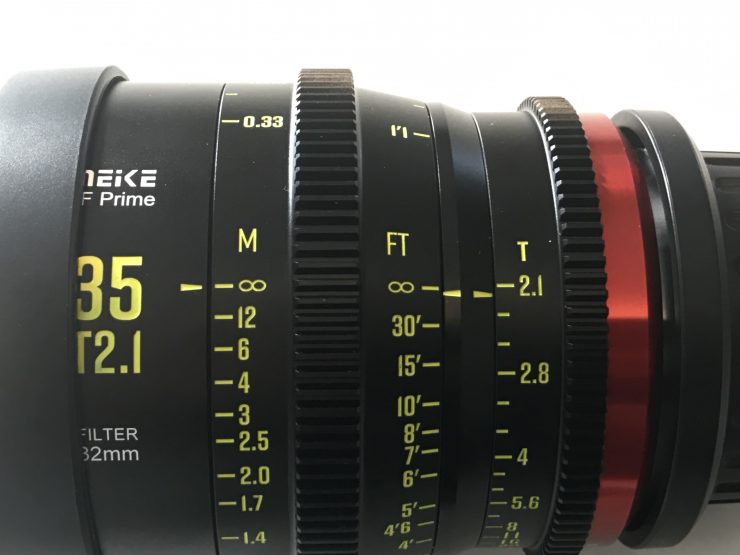
The thing I did notice is that the infinity marking in meters and feet doesn’t line up with the infinity marking for feet. Again, this might be a minor complaint, but both of them should line up.
Other Features
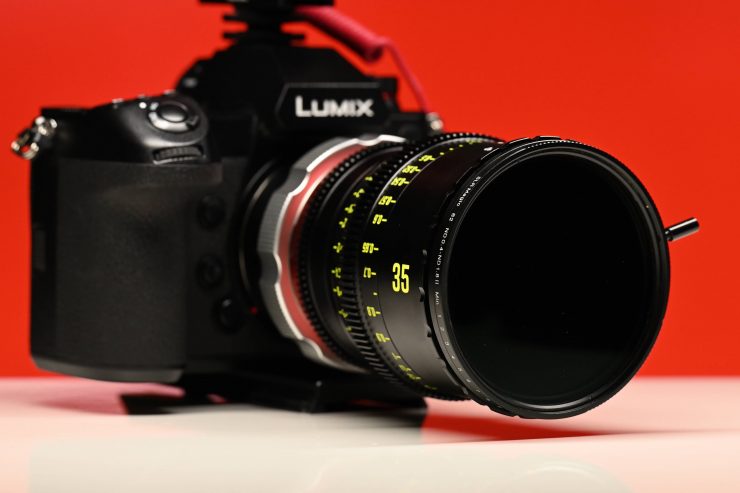
The lens has an 82mm front filter diameter so you can easily attach common sized filters. The front diameter of the lens is 85mm. This allows you to use some clamp-on matte boxes with the corrector adaptor ring.
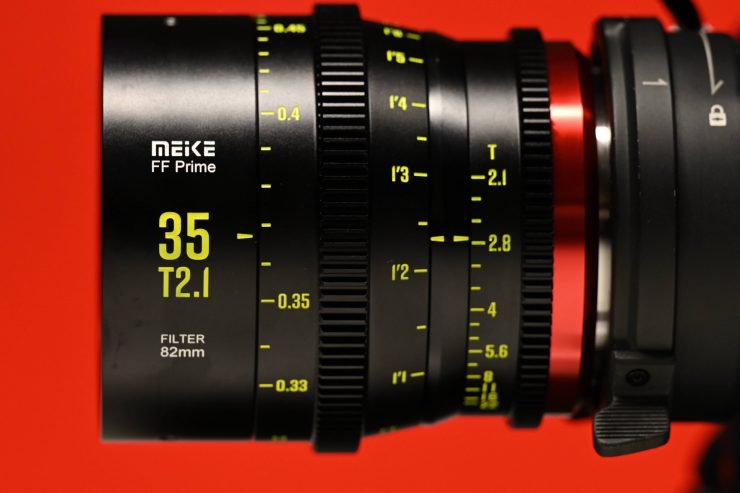
The minimum focusing distance is 33cm (12.99″). This is really nice as it allows you to focus on objects that are very close to the lens. A full-frame sensor with a 35mm lens and a nice close focussing ability lets you create some interesting shots.
The lens has a focus throw of 330 Degrees and both the iris and focus ring feature industry-standard 0.8 pitch gears. It is possible to manually pull focus from infinity to the minimum focusing distance in one go, despite the large 330 degrees of rotation. This is mainly because the physical size of the lens barrel isn’t that big.
Is it actually a cine lens or just a rehoused stills lens?
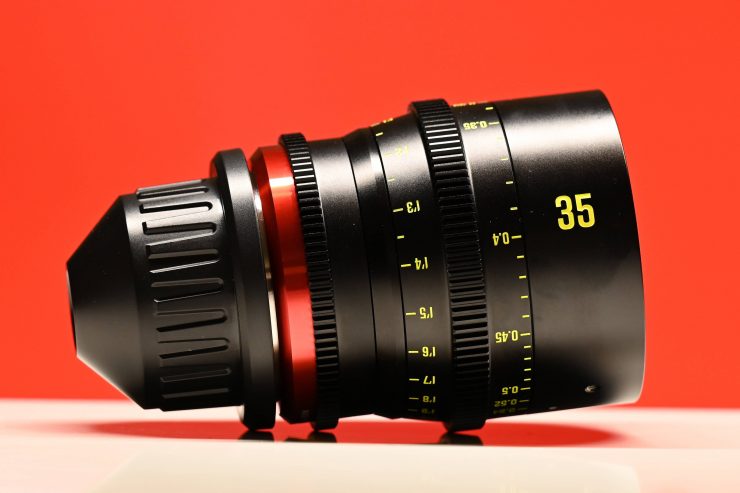
According to MEIKE, this is a purpose-built cine design and not a rehoused stills lens.
Optical Structure
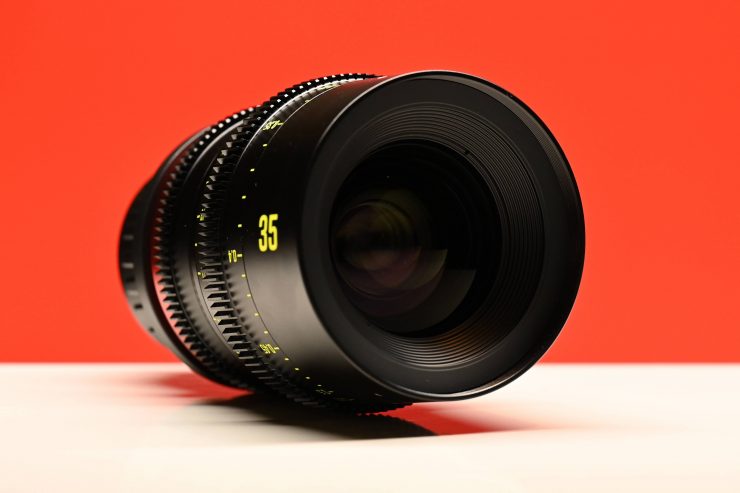
The 35mm T2.1 consists of 14 Elements in 9 Groups. The lens also has 11 aperture blades.
No Breathing?
I tested out the lens by doing large focus throws with an electronic follow focus and there is definitely some breathing. Whether you find it distracting or not, I’ll leave that up to you. For a lens at this price, the breathing is still reasonably well controlled.
No lens technically has zero breathing, but very good cinema glass has such minimal amounts that it is virtually impossible to see. What you will always see is some perspective shift which is normal when refocusing a lens.
Image shift is the change in location of a fixed point after a focus rack. It should be in the same spot after you rack focus.
Perspective shift is the focal length of the lens being modified by the movement of the optics. A slight change in focal length may happen if there is a floating element that moves and is not properly corrected for in the design. Certainly, the great majority of lenses have this issue. It’s also tenths of a mm so not overly noticeable.
Focus breathing is a change in image size so the size of object will get larger as it moves out of frame. That is reproduction size.
In summary,
Fall off and Vignetting
I didn’t notice any real noticeable fall of or vignetting when using this lens on a Kinefinity MAVO LF, Panasonic S1H, or Nikon Z6.
Sharpness
This isn’t a fast prime lens, so I would expect the sharpness to be reasonably good, even when using it at T2.1. The lens is fairly sharp, even when used wide open.
As you can see in my tests, sharpness does improve as you stop the lens down. This comes as no surprise as most lenses are generally sharper once they are stopped down.
Edge sharpness is still reasonably good, but it is certainly softer out towards the edge of frame than it is in the center. Stopping down the lens to T4 to T5.6 does improve edge sharpness.
This is a sharp enough lens that you can certainly use it wide open. For a sub $1,000 USD full-frame cine lens the sharpness is more than acceptable.
All the tests were shot on the Kinefinty MAVO LF.
Lens Flare
I personally didn’t like the lens flare from the Meike, but that is just my personal opinion. Wide-open it does produce quite a bit of veiling and you don’t get much in the way of nice flaring. Please bear in mind that lens flare is very subjective.
In certain shooting situations, the lens does lose some contrast when a bright light source is coming directly down the barrel.
When you stop down to T5.6 the flare and veiling are very well controlled. I personally preferred the look of the flare when you use the lens stopped down.
Chromatic Aberration
The lens doesn’t have any real-world visible chromatic aberration. Even if you zoom in 300% when used at T2.1 it is hard to notice anything. On a chart, you can see a tiny amount, but it is not something you are going to encounter in the real world. The lack of chromatic aberration is nice to see, but in saying that, with a T2.1 lens I didn’t expect to be seeing any in the first place.
Bokeh
Nice bokeh is something you want if you are purchasing a prime lens. Despite only having a T2.1 maximum aperture, you can create some nice bokeh because the lens has 11 aperture blades. The bokeh produced is reasonably nice and round and you can create some beautiful out of focus areas by using the lens wide open. Wide-open at T2.1 you can see some chromatic aberration and color bleed on the bokeh, but only if you look very carefully. Again, in the real world, this is not something that I think most people will notice.
There is the slightest amount of bokeh onion ring action occurring, but again, you have to look very hard to see it.
The bokeh is nice for a lens with a T2.1 aperture. It is nice and round and even when you stop the lens down it doesn’t turn into too much of a stop sign shape.
Color Tone
The lens is fairly neutral when it comes to color, if anything it is slightly cooler in tone. I would liken the color tone to a lot of Zeiss lenses.
The color tone of a lens is really something you should look at closely if you are going to be using both prime and zoom lenses from different manufacturers. Certain prime and zoom lenses work better together than others. What will work for you will also depend on what camera you are using.
Real World Thoughts
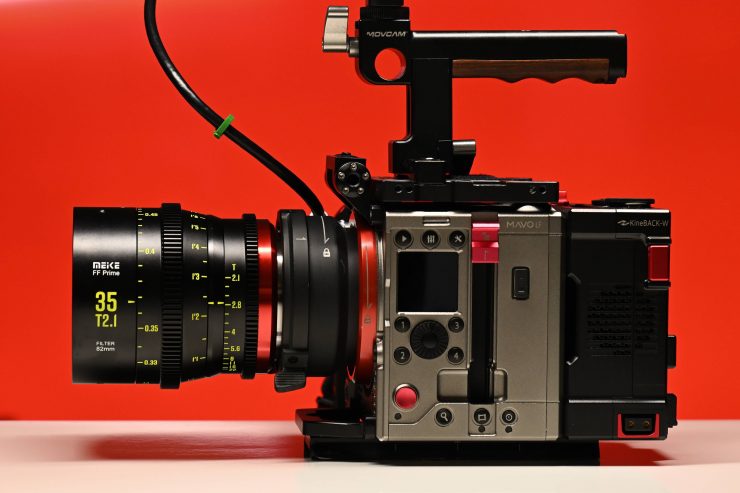
The Meike 35mm T2.1 Full Frame Cine Lens is an impressive offering, especially given its relatively low entry cost. The lens isn’t going to look as good as more expensive offerings, but none the less it is still impressive given its sub $1000 USD price. While it is far from optically perfect it strikes a good balance of price and performance.
Despite only having a T2.1 maximum aperture, the lens is still capable of creating good separation from your background and the bokeh is pleasing.
The build quality and mechanics are good, especially at this price point. The iris and focus are reasonably well-weighted, but they don’t seem to have even tension throughout their whole range.

With the industry pushing forward with larger sized sensors, investing in full-frame and larger glass is a pretty solid investment. Regardless of whether you are using cameras with S35 sized, or full-frame sensors, investing in glass that can cover both is a good idea.
More Focal Lengths Coming
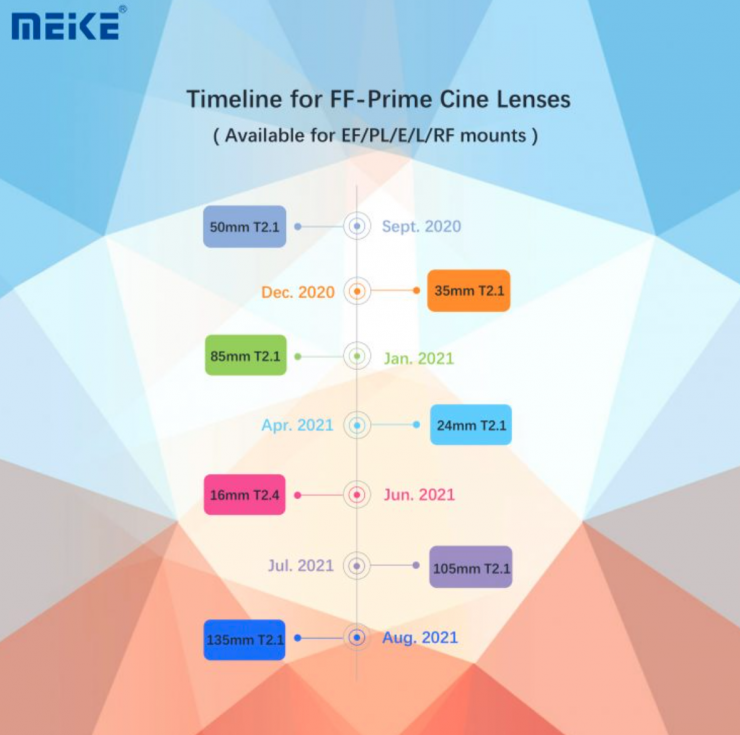
MEIKE will be releasing more focal lengths going forward. The planned set will include:
- 16mm T2.4
- 24mm T2.1
- 35mm T2.1
- 50mm T2.1
- 85mm T2.1
- 105mm T2.1
- 135mm T2.1
I’m not the biggest fan of companies trickle releasing focal lengths. It makes a lot more sense to announce at least three lenses at once. Not many shooters want to purchase a single focal length prime lens. Not having a number of focal lengths available at the same time is bound to put some potential buyers off.
Price & Availability
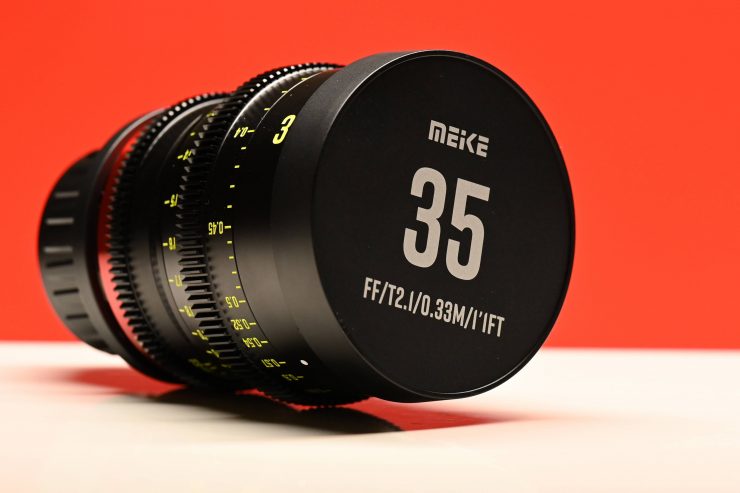
The Meike Prime 35mm T2.1 retails for $958 USD and it will start shipping this month. It is now available to pre-order.
Competition
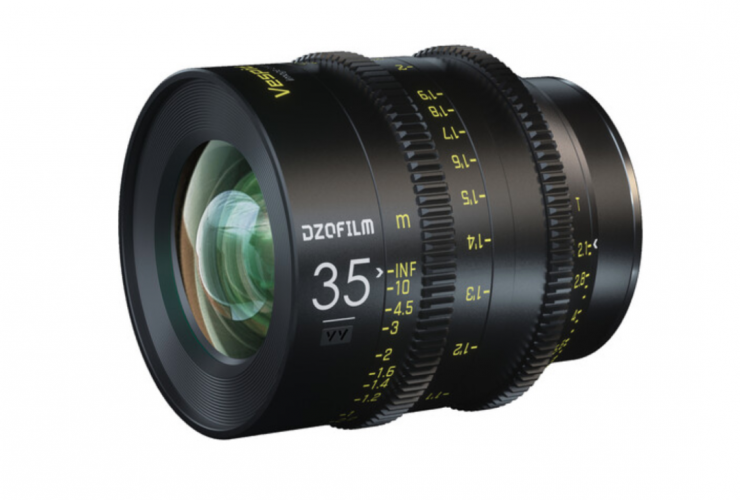
There is quite a lot of competition in the full-frame cinema prime marketplace, especially for lenses that come in either PL or EF mount. This makes choosing a cine prime lens a very difficult task.
As far as affordable Canon EF or PL mount cine prime options are concerned, lenses like the SLR Magic APO MicroPrime Cine lenses and DZOFilm VESPID 35mm T2.1 Lens are direct competition. They have the same T-stop and are all relatively close when it comes to price. However, the SLR Magic only comes in EF mount.
So how does the DZOFilm compare to the Meike when it comes to specifications and price?
| Meike 35mm T2.1 | DZOFilm VESPID 35mm T2.1 | |
| Lens Mount | PL/EF/RF/E/L | PL/EF |
| Image Circle | 45mm | 46.5mm |
| MFD | 12.99″ / 33cm | 11.8″/ 30cm |
| Iris Blades | 11 | 16 |
| Filter Thread | 82mm | 77mm |
| Focus Rotation | 330° | 270° |
| Weight | 39.04 oz / 1108g | 29.4 oz / 834 g |
| Price | $958 USD | $1,249 USD |
As you can see, both lenses have fairly similar specifications. The DZOFilm is lighter and it has more iris blades. The Meike has a larger focus rotation, it is available in more mounts, and it is cheaper.
Optically I have no idea how these lenses compare as I have not had a chance to try out any of the DZOFilm VESPID primes.
Do you need a full-frame cinema lens?
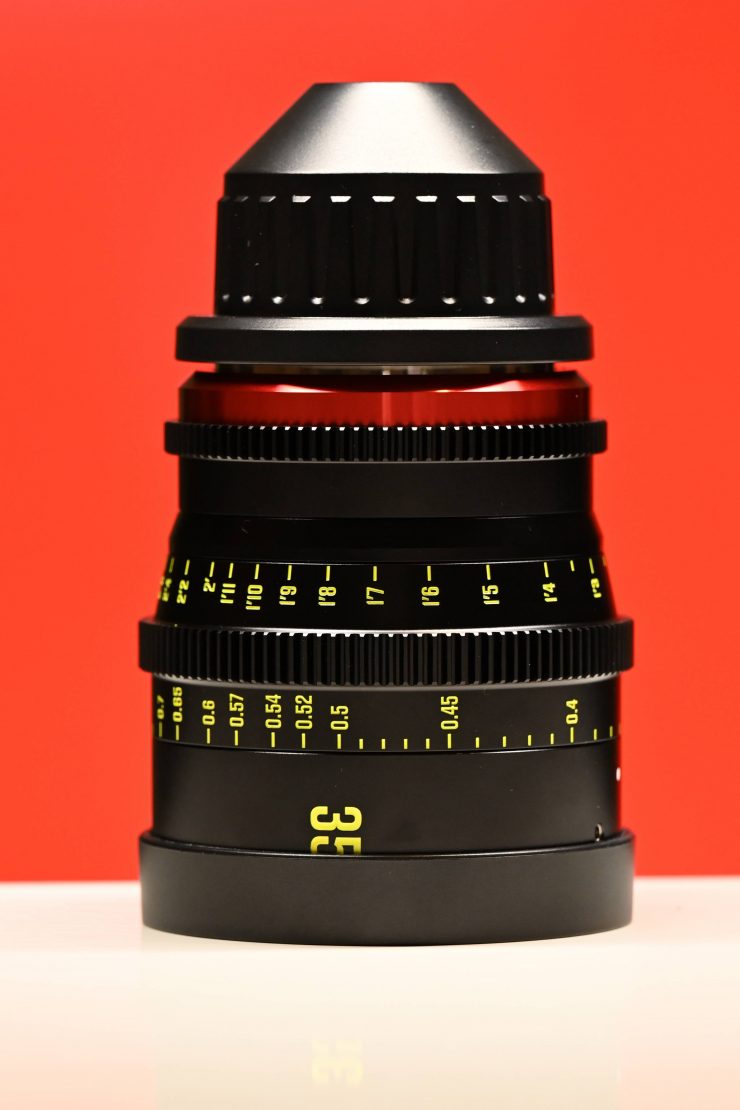
With lots of relatively affordable full-frame digital cinema cameras such as the Canon C500 Mark III, Sony FX9, Sony FX6, Kinefinity MAVO LF, and the Z CAM E2-F6 Full-Frame 6K and 8K now available, as well as a plethora of full-frame mirrorless cameras, buying full frame lenses makes a lot of sense.
There is certainly a push by manufacturers to bring out full-frame and larger digital cinema cameras, so lenses that cover full-frame and larger sensors are going to become more popular.
I don’t generally shoot on a full-frame digital cinema camera, but I have still personally chosen to invest in full-frame prime lenses. I did this because the industry is moving quickly and I would prefer to spend my money on something that is going to be slightly more future proof than a lens that just covers an S35 sensor.
Investing in a full-frame lens is usually going to cost you a lot more money than buying one that just covers S35 sensors, however, some of the latest lens offerings from Meike and DZOFilm are starting o buck that trend.
Conclusion
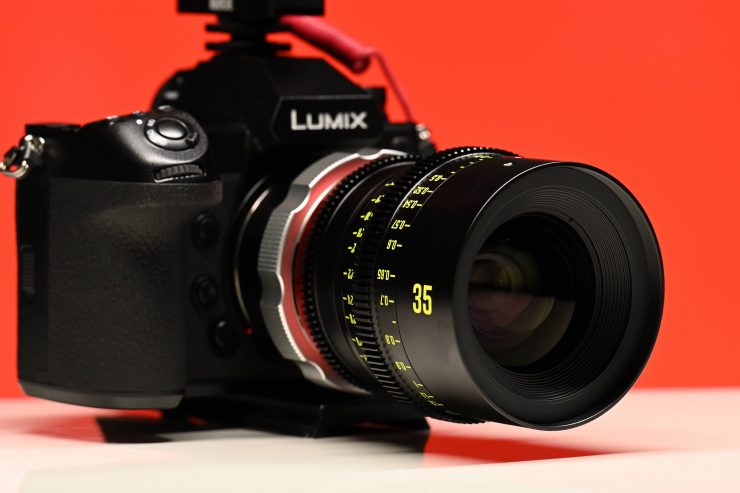
The Meike 35mm T2.1 Full Frame Cine Lens does a good job. There is nothing overly exciting about the lens, but it is a solid offering.
It offers good performance in a relatively compact and affordable package. The reason this lens is less than $1,000 USD is that it is only T2.1 You usually can’t have your cake and eat it too. If you wanted a faster lens and better optical performance then that usually comes at a cost.
The mechanics and build quality are good for a sub $1,000 USD lens. The 330 degrees of focus rotation allows you to make finite focus adjustments without the associated problems of using stills glass. The barrel is significantly small enough that you can pull focus from infinity to the minimum focus distance by hand, but this does require a bit of effort.
Having an 82cm front filter thread allows you to use common sized filters which is important if you plan on using this lens on mirrorless, DSLR, or small-sized digital cinema cameras that don’t have built-in ND. The 85mm front lens diameter means you can also use clamp-on matte boxes with the appropriately sized set down ring.
Meike has done a really good job with this lens, and I think once they have more focal lengths available they are bound to be a popular choice with shooters. They do, however, face stiff competition from companies such as DZOFilm.
As far as price v’s performance is concerned, the Meike is very hard to beat if you are looking for an affordable purpose-made cine lens that covers full-frame and larger sensors.
Like what we do and want to support Newsshooter? Consider becoming a Patreon supporter and help us to continue being the best source of news and reviews for professional tools for the independent filmmaker.

